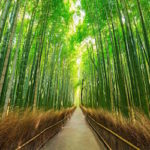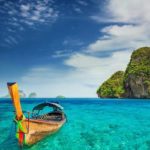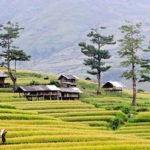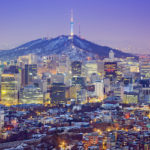Vietnam Travel Guide
Information about tourism in Vietnam
-Language: Vietnamese (majority of population)
-Official currency: VND (₫)
-Population: Nearly 100 million (updated on March 2022)
-Number of tourists: 18 million international visitors to Vietnam in 2019
-Destinations not to be missed: Halong Bay, Hoian, Ninh Binh, Hanoi, Mekong Delta
Should I travel on my own or choose a packages tour?
Although the official language is Vietnamese, many young people in Vietnam can communicate by English, especially in big cities. Therefore, if you are young, dynamic and want to do everything on your own, then you can completely travel to Vietnam by yourself, however, before you go, you should carefully research and book for some services such as destinations, itinerary, hotels, domestic flight, transportation, etc.
In case you take a tour with family or a small group of friends, choosing and booking a Vietnam tour packages will be better, like that, your travel agency will do everything for you.
Where to go in Vietnam if I have…
1/2 Week
If you have about ½ week, you should go to the North of Vietnam with two main destinations: Hanoi and Halong Bay. Normally, you will spend 1 day visiting Hanoi and 2 days/1 night on the overnight cruise in Halong Bay. Or you can also reduce 1 day for Halong Bay by taking a boat tour and cruising around the bay in 4 hours then returning to Hanoi. The rest of the trip, you will visit Ninh Binh which is known as “Halong Bay on land”.
1 Week
If you have 1 week, there are three options you can consider:
-Option 1: Beside 3 mentioned destinations (Hanoi, Halong Bay, Ninh Binh), you will spend 2 days visiting Sapa. With this option, you will spend the whole trip in Northern Vietnam.
-Option 2: Beside 3 mentioned destinations, you will fly (1.10 minutes) to Central Vietnam where you will spend 1 day for Hue, 2 days for Hoian. After that, you will take an international flight back home from the airport in Da Nang.
-Option 3: Beside 3 mentioned destinations, you will fly (2.20 minutes) to Southern Vietnam where you will spend 1 day for Ho Chi Minh City & Cu Chi Tunnels, 2 days for Mekong Delta. After that, you will take an international flight back home from the airport in Ho Chi Minh City.
2 Weeks
2 weeks is the best as you will visit the most highlighted destinations in Vietnam. You will start the trip in Northern Vietnam for about 6 days with these destinations: Hanoi, Halong Bay, Sapa and Ninh Binh then fly to Central Vietnam and spend about 5 days there to visit Hue, Hoian, Golden Bridge and Da Nang. The remaining 3 days will be for Southern Vietnam with 2 main destinations: Ho Chi Minh City and Mekong Delta.
3 Weeks or more
From 3 weeks, besides mentioned destinations in 3 regions within 2 weeks. There are few more options depending on your interests:
-If you like a beach holiday in Vietnam, then the best option is to fly to Phu Quoc Island and spend the rest of your trip relaxing in Phu Quoc Beach. Or you can also choose another beach like Nha Trang or Mui Ne.
-If you do not like beach very much and want to learn more about local culture, see more nature or interact more with the locals, you can spend the rest of trip in the North Vietnam to visit Ha Giang, Ban Gioc waterfall or Babe lake, or you can also increase the length of your trip in Mekong Delta.
-As Cambodia is next to Vietnam, it will be very convenient for moving between the two countries, so with the length of trip as above (2 or 3 weeks), you can consider a tour combining two countries: Vietnam & Cambodia.
What to buy in Vietnam?
Áo Dài (Vietnamese long dress)
Áo Dài, Vietnam’s national costume is the pride of Vietnamese fashion. This is a type of clothing that shows beauty, grace and elegance, it is made of two parts: a long-sleeved, body-hugging top and a pair of trousers. Áo Dài will make you look sexy with beautiful curves but still polite and discreet enough to wear in important events.
Thêu Tay (Hand embroidery)
Embroidery art is very popular in Vietnam and is used as a souvenir. It is definitely one of the things to buy as a gift as they do not take up much space in your suitcase. Embroidery products in Vietnam are mainly about natural, wildlife and are easily found in tourist souvenir shops.
Đồ Gốm (Pottery)
Since hundreds of years ago, Vietnam was too famous for 3 things: pottery, weaving and stone carving but pottery is the most famous and appreciated. Today, there are 3 popular traditional pottery villages in Vietnam: Thanh Ha in Hoian, Phuoc Tich in Hue and Bat Trang in Hanoi.
Sơn Mài (Lacquer)
Vietnam has a long-standing tradition of lacquer craft. Lacquer products in Vietnam are jewelry boxes, photo albums, plates, bowls, flowerpots and all have different designs with good quality when compared to products from other countries. Although the lacquer factories are very developed in Hue, Hoian, Hanoi and Ho Chi Minh City, you can find this souvenir in many tourist destinations.
O Mai (Dried fruit)
O Mai is a specialty of Vietnam, it is dried fruit and soaked in sugar or salt, then mixed with other spices to get a harmonious taste. The most common fruits used to make O Mai are apricot, plum, peach, kumquat and mango. This is the best gift for people who love dried fruit.
Trà (Vietnamese tea)
Tea is one of the favorite drinks of Vietnamese people of all ages and it plays an important role in Vietnamese culture. This beverage always brings a sense of peace to everyone, even when they are busy, but you should avoid drinking tea in the evening because it can make you feel hard to sleep.
Quạt Tay (Hand fan)
In the past, a hand fan was an indispensable thing in any house in Vietnam and it was used for cooling in summer days. Today, tourists can see colorful hand fans in some traditional Vietnamese dances. Traditional hand fan materials include paper and bamboo frames while modern hand fans can be made from silk or other fabrics.
Búp Bê Rối Nước (Wooden Puppet)
Water puppetry is the greatest art of Vietnam for many centuries. If you love wooden puppets after seeing a water puppet show, you can buy some to take home as souvenirs for your family/friend.
Kẹo Dừa (Coconut Candy)
Talking about coconut, people usually only think of coconut water, but in Vietnam, the people here have created a sweet and delicious coconut candy. Coconut candy is sourced from the Mekong Delta. For better taste, you should enjoy coconut candy with a cup of tea. Coconut candies are almost made in Ben Tre, but you can find them in every supermarket or tourist destination.
Lụa (Silk)
Silk in Vietnam is used in many Vietnamese costumes, including the traditional Áo Dài. The extremely diverse, beautiful colors and patterns of Vietnamese silk will satisfy all the needs of tourists. In Vietnam, the two best places to buy silk are Van Phuc Silk Village in Hanoi or Hoian Silk Village in Hoian.
Nón Lá (Conical hat)
Made mainly of palm leaves and bamboo, Nón Lá was used to shelter farmers who worked under the scorching sun day or the sudden summer rains. Today, Nón Lá is only used in rural areas and sold to tourists as souvenirs.
Lồng Đèn (Handmade lantern)
Since the 3rd century BC, Chinese merchants came to Hoian and brought beautiful lanterns here to light up their homes. Over time, the locals learned how to make and invented the affordable lantern themselves, which has become a cultural beauty and one of the symbols of Hoi An’s Old Town.
Café Phin (Vietnamese coffee)
Besides food, Vietnamese coffee is the best thing that every Vietnamese is proud to bring to the world. Completely different from other countries, Vietnamese people use a special filter called “Phin” and have to wait for a while when the coffee soaks into hot water, then each drop of coffee slowly falls into the cup. The thick liquid with the color of cockroach wings and super fragrant has captivated many visitors when they tried it.
May Đo (Tailored clothing)
From formal suits to casual dresses, you can find tailors to customize your clothing at the best price. If you have any ideas on how you would like your suit/dress to look, the tailors will be ready to accommodate on your request.
Tiêu (Pepper)
In Vietnam, especially Phu Quoc, pepper is a popular choice by tourists. Phu Quoc pepper is famous for its quality, delicious taste and aroma. There are three common types of pepper in Vietnam including black pepper, white pepper and red pepper.
What is the best weather and best time to travel to Vietnam?
Vietnam is a long and narrow country with different regions which can be affected by different weather conditions at the same time, like that, it is quite difficult to find the best time to visit this country. Normally, Vietnam has 3 main regions (Northern, Central and Southern) with different climates.
Northern Vietnam is divided into 4 distinct seasons with Spring from Feb – April, Summer from May – Aug, Autumn from Sep – Nov and Winter from Dec – Jan. Weather in Spring and Autumn is very cool and there is no rain in the North while the Winter is cold with temperatures from 8 – 15oC. Summer in the North is hot with temperatures from 30 – 38oC and this period is also the rainy season in the North.
Weather in the Central region is quite similar to the North but not as clear & different as the season in the North. The weather in this region is also not hotter or colder than in the North.
Contrary to North & Central regions, the South has only rainy and sunny seasons with warm and sunny weather (sometimes hot) all year round with temperature from 28 – 35oC. Rainy season is usually from June to Sep while the dry season is from Oct – April.
Therefore, in our opinion and for most tourists, the best season for visiting Vietnam is from Oct to April. However, if coming to Vietnam in May – Sep is also not a bad idea because that period will have less visitors, you will have more space to travel and you will have a better experience for all the activities on the beach.
How much is the daily cost for traveling in Vietnam?
Your trip’s budget will depend on how you want to travel. If you choose to stay at a cheap hotel, eat at street food/casual restaurants, move by public transport like shuttle bus, etc. You can spend about 45 USD /per person/per day.
If you are looking for a luxury, enjoyment and convenience trip, the trip’s price will be around 150 to 300 USD / per person / per day. Like that, you will stay at 4, 5 stars accommodation with a private tour guide and private transport throughout the trip.
Currency in Vietnam
The official currency of Vietnam is Vietnam Dong (VND / đ) with these denominations: 1,000; 2,000; 5,000; 10,000; 20,000; 50,000; 100,000; 200,000 and 500,000. The exchange rates between Vietnamese Dong (VND) and other currencies are around:
- 1 USD = 23,000 VND
- 1 EUR = 26,000 VND
- 1 GBP = 30,000 VND
- 1 AUD = 18,000 VND
You can exchange money at the airport upon arrival or at some national banks (Vietcombank, Techcombank, TP Bank, etc.) or international banks (Shinhan Bank, Public Bank, ANZ, HSBC, etc.). You can also exchange at specialized foreign currency trading points in Hanoi (Ha Trung street) or Ho Chi Minh City (Bui Vien street)
ATMs are also easy to find in some big cities, but if you go to rural areas, you should bring enough cash with you.
Transportation in Vietnam
Moving within 1 city
Taxi is an easy way to get around the city but, in our opinion, we recommend you should use Grab. Grab is widely used in Vietnam, this transport service has been present in the whole of Vietnam with better price, better service and the quality of vehicle are also better than a Taxi.
Cyclo is an interesting transportation and you should experience it while you are in Vietnam. However, don’t book it yourself, ask the staff at your hotel to book the cyclo for you, before boarding, please be clear about price as well as point of arrival with the driver.
Besides, you can also rent a bicycle or a motorbike at your hotel. However, you should not rent a motorbike and drive by yourself in Vietnam, the traffic here is really crazy, chaotic and unsafe.
Moving between cities
If you have to move between a few cities (Ex: North to Centre then to South), you can choose to fly popular airlines such as Vietnam Airlines, Viet Jet Air or Bamboo Airways. You can also move by train but the quality of trains in Vietnam is quite bad.
Sample tour itinerary for 1st time visitor in Vietnam
A popular tour itinerary in Vietnam will include 3 regions: North, Centre and South.
You will arrive at Noi Bai airport (Hanoi) first, after visiting popular destinations in the North such as Hanoi, Halong Bay, Ninh Binh (or Sapa). You will take a flight to the Centre for visiting Hue, Hoian and Da Nang. You then take another flight to the South for visiting 2 main destinations: Ho Chi Minh City and Mekong Delta. Kindly check out some of our popular tour itineraries here so that you can get more ideas for your tour in Vietnam.
Safe travel in Vietnam
Vietnam is a safe country for foreign tourists and Vietnamese people always welcome foreign visitors. Stable political condition and no terrorism in Vietnam are a strong point. However, like other countries in the world, Vietnam also has crime such as robbery, stealing, etc. but it shouldn’t be a problem if you take usual precautions: don’t wear expensive jewelry, passports and other important documents should be left in a small travel bag.
In addition, when walking or riding on a cyclo, you can be robbed by motorbike robbers, so be careful of expensive items such as camera, mobile phone, necklace, etc.
Ho Chi Minh City is a place where you should be more careful of crime on streets like pickpockets and scammers. Be wary of innocent-looking kids and old ladies who can be bait for thieves – especially in popular tourist attractions.
Traveling with kids in Vietnam
The main concern will probably be hygiene, as some places in Vietnam may not be as hygienic as European or North American countries. Therefore, when visiting Vietnam with kids, you should avoid letting your kids eat or drink on the streets. It is advisable that you should let your kid eat at restaurants that are served to foreign tourists.
Regarding health, there are many international hospitals in big cities like Hanoi and Ho Chi Minh City, but before coming to Vietnam, you should buy travel insurance for you and your family.
Female tourists traveling in Vietnam
Vietnam is a safe country for female travelers. However, it is better to take the usual precautions if you are a woman traveling alone such as avoiding walking very late on the street and not wearing sexy clothes.
Do & Don’t in Vietnam
-Do not bring valuables during a walking tour. Do not wear expensive jewelry to avoid the attention of thieves.
-Be careful of luggage, wallet, mobile phone, camera, laptop, backpack when traveling on the road, especially in Ho Chi Minh City. Always keep personal belongings with you. One of the most common ways that valuable things can be easily snatched by a motor-biker at high speed. Dangers of pickpockets can come from distraction. The scenario could be: one person tries to distract you by asking, directing or asking for help while others will try to steal your valuable things.
-Pay attention when crossing the road. If you can’t cross the road alone, just follow the locals. You can see the traffic here is really chaotic and sometimes it doesn’t follow any regulations.
-Say no to street vendors and beggars, don’t stop and show your concern to them. Just say no and keep moving, ignoring them.
-Don’t go on a cyclo tour and call a taxi by yourself. Not all but a few of them can deceive you. If you want to join a cyclo tour, you should ask your local tour operator for help. They give you a clear price and clear route. If you want to take a taxi, you should ask the hotel staff for help. They will call a taxi driver they know well for you.
-Do not wear revealing clothes. Doesn’t show too much skin. Some places such as mausoleums and temples will request not to wear tank tops or short shorts.






